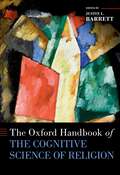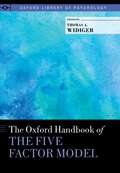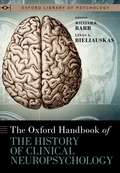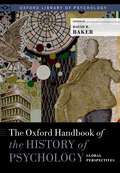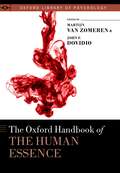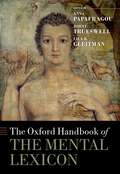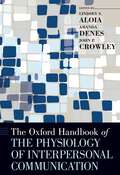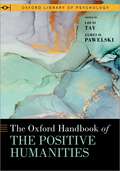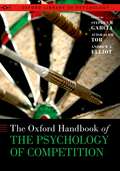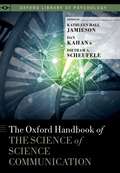- Table View
- List View
The Oxford Handbook of Substance Use and Substance Use Disorders: Volume 1 (Oxford Library of Psychology)
Substance use and substance use disorders (SUDs) have been documented in a number of cultures since the beginnings of recorded time and represent major societal concerns in the present day. The Oxford Handbook of Substance Use and Substance Use Disorders provides comprehensive reviews of key areas of inquiry into the fundamental nature of substance use and SUDs, their features, causes, consequences, course, treatment, and prevention. It is clear that understanding these various aspects of substance use and SUDs requires a multidisciplinary perspective that considers the pharmacology of drugs of abuse, genetic variation in these acute and chronic effects, and psychological processes in the context of the interpersonal and cultural contexts. Comprising two volumes, this Handbook also highlights a range of opportunities and challenges facing those interested in the basic understanding of the nature of these phenomena and novel approaches to assess, prevent, and treat these conditions with the goal of reducing the enormous burden these problems place on our global society. Chapters in Volume 1 cover the historical and cultural contexts of substance use and its consequences, its epidemiology and course, etiological processes from the perspective of neuropharmacology, genetics, personality, development, motivation, and the interpersonal and larger social environment. Chapters in Volume 2 cover major health and social consequences of substance involvement, psychiatric comorbidity, assessment, and interventions. Each chapter highlights key issues in the respective topic area and raises unanswered questions for future research. All chapters are authored by leading scholars in each topic. The level of coverage is sufficiently deep to be of value to both trainees and established scientists and clinicians interested in an evidenced-based approach.
The Oxford Handbook of Suicide and Self-Injury (Oxford Library of Psychology)
by Matthew K. NockSuicide is a perplexing human behavior that remains among the leading causes of death worldwide, responsible for more deaths each year than all wars, genocide, and homicide combined. Although suicide and other forms of self-injury have baffled scholars and clinicians for thousands of years, the past few decades have brought significant leaps in our understanding of these behaviors. This volume provides a comprehensive summary of the most important and exciting advances in our understanding of suicide and self-injury and our ability to predict and prevent it. Comprised of a formidable who's who in the field, the handbook covers the full spectrum of topics in suicide and self-injury across the lifespan, including the classification of different self-injurious behaviors, epidemiology, assessment techniques, and intervention. Chapters probe relevant issues in our society surrounding suicide, including assisted suicide and euthanasia, suicide terrorism, overlap between suicidal behavior and interpersonal violence, ethical considerations for suicide researchers, and current knowledge on survivors of suicide. The most comprehensive handbook on suicide and self-injury to date, this volume is a must-read text for graduate students, fellows, academic and research psychologists, and other researchers working in the brain and behavioral sciences.
The Oxford Handbook of Synesthesia
by Julia SimnerSynesthesia is a fascinating phenomenon which has captured the imagination of scientists and artists alike. This inherited condition gives rise to a kind of 'merging of the senses', and so for those who experience it, everyday activities like reading or listening to music trigger extraordinary impressions of colours, tastes, smells, shapes and other sensations. Synesthesia research also informs us about normal sensation because all people experience cross-sensory mappings to an implicit degree. Synesthesia has a considerably broad appeal, and in recent decades the field has experienced a resurgence of interest. These advances have painted a detailed story about the development, genetics, psychology, history, aesthetics and neuroscience of synesthesia, and provide a contemporary source of study for a new generation of scholars. The Oxford Handbook of Synesthesia brings together this broad body of knowledge into one definitive state-of-the-art handbook. It includes a large number of concisely written chapters, under broader headings, which tackle questions about the origins of synesthesia, its neurological basis, its links with language and numbers, attention and perception, and with 'normal' sensory and linguistic processing. It asks questions about synesthesia's role in language evolution, and presents both contemporary and historical overviews of the field. It shows synaesthesia's costs and benefits (e.g., in creativity, memory, imagery) and describes how synaesthesia can provide inspiration for artists and designers. The book ends with a series of perspectives on synesthesia, including a first-hand account, and philosophical viewpoints which show how synaesthesia poses unique questions about sensation, consciousness and the nature of reality.
The Oxford Handbook of Synesthesia
Synesthesia is a fascinating phenomenon which has captured the imagination of scientists and artists alike. This inherited condition gives rise to a kind of 'merging of the senses', and so for those who experience it, everyday activities like reading or listening to music trigger extraordinary impressions of colours, tastes, smells, shapes and other sensations. Synesthesia research also informs us about normal sensation because all people experience cross-sensory mappings to an implicit degree. Synesthesia has a considerably broad appeal, and in recent decades the field has experienced a resurgence of interest. These advances have painted a detailed story about the development, genetics, psychology, history, aesthetics and neuroscience of synesthesia, and provide a contemporary source of study for a new generation of scholars. The Oxford Handbook of Synesthesia brings together this broad body of knowledge into one definitive state-of-the-art handbook. It includes a large number of concisely written chapters, under broader headings, which tackle questions about the origins of synesthesia, its neurological basis, its links with language and numbers, attention and perception, and with 'normal' sensory and linguistic processing. It asks questions about synesthesia's role in language evolution, and presents both contemporary and historical overviews of the field. It shows synaesthesia's costs and benefits (e.g., in creativity, memory, imagery) and describes how synaesthesia can provide inspiration for artists and designers. The book ends with a series of perspectives on synesthesia, including a first-hand account, and philosophical viewpoints which show how synaesthesia poses unique questions about sensation, consciousness and the nature of reality.
The Oxford Handbook of the Cognitive Science of Religion (Oxford Handbooks)
by Justin L. BarrettWhy have religious beliefs and behaviors been nearly universal in human societies? What accounts for similarities and differences across time and across cultures? Could the answer lie in the human brain? Scholars in the cognitive science of religion (CSR) believe that it can- the prevalence of religion is a result of the way our minds work. CSR advances in psychology explain various patterns in religious thought and action. This scientific approach has grown rapidly over the past couple of decades. However, it has often been conflated with related subjects such as evolution and neuroscience. CSR is neither: it straddles the line between cognitive sciences and the study of religion. The Oxford Handbook of the Cognitive Science of Religion directly identifies CSR's unique contributions and clarifies its relationship to neighboring disciplines. With contributions from the field's founders and its rising stars, this volume offers a critical overview of more than 25 years of research. From discussions of human nature to the role of ritual, the contributors offer comprehensive and in-depth analysis of key questions in CSR. Readers will have a variety of entry points to truly grasp where CSR has been, where it is, and where it might go.
The Oxford Handbook of the Cognitive Science of Religion (Oxford Handbooks)
Why have religious beliefs and behaviors been nearly universal in human societies? What accounts for similarities and differences across time and across cultures? Could the answer lie in the human brain? Scholars in the cognitive science of religion (CSR) believe that it can- the prevalence of religion is a result of the way our minds work. CSR advances in psychology explain various patterns in religious thought and action. This scientific approach has grown rapidly over the past couple of decades. However, it has often been conflated with related subjects such as evolution and neuroscience. CSR is neither: it straddles the line between cognitive sciences and the study of religion. The Oxford Handbook of the Cognitive Science of Religion directly identifies CSR's unique contributions and clarifies its relationship to neighboring disciplines. With contributions from the field's founders and its rising stars, this volume offers a critical overview of more than 25 years of research. From discussions of human nature to the role of ritual, the contributors offer comprehensive and in-depth analysis of key questions in CSR. Readers will have a variety of entry points to truly grasp where CSR has been, where it is, and where it might go.
The Oxford Handbook of the Development of Imagination (Oxford Library of Psychology)
by Marjorie TaylorChildren are widely celebrated for their imaginations, but developmental research on this topic has often been fragmented or narrowly focused on fantasy. However, there is growing appreciation for the role that imagination plays in cognitive and emotional development, as well as its link with children's understanding of the real world. With their imaginations, children mentally transcend time, place, and/or circumstance to think about what might have been, plan and anticipate the future, create fictional relationships and worlds, and consider alternatives to the actual experiences of their lives. The Oxford Handbook of the Development of Imagination provides a comprehensive overview of this broad new perspective by bringing together leading researchers whose findings are moving the study of imagination from the margins of mainstream psychology to a central role in current efforts to understand human thought. The topics covered include fantasy-reality distinctions, pretend play, magical thinking, narrative, anthropomorphism, counterfactual reasoning, mental time travel, creativity, paracosms, imaginary companions, imagination in non-human animals, the evolution of imagination, autism, dissociation, and the capacity to derive real life resilience from imaginative experiences. Many of the chapters include discussions of the educational, clinical, and legal implications of the research findings and special attention is given to suggestions for future research.
The Oxford Handbook of the Five Factor Model (Oxford Library of Psychology)
by Thomas A. WidigerThe Five Factor Model, which measures individual differences on extraversion, agreeableness, conscientiousness, emotional stability, and openness to experience, is arguably the most prominent dimensional model of general personality structure. In fact, there is now a considerable body of research supporting its construct validity and practical application in clinical, health, and organizational settings. Taking this research to the forefront, The Oxford Handbook of the Five Factor Model showcases the work of expert researchers in the field as they each offer important insight and perspective on all that is known about the Five Factor Model to date. By establishing the origins, foundation, and predominance of the Five Factor Model, this Handbook will focus on such areas as construct validity, diagnosis and assessment, personality neuroscience, and how the Five Factor Model operates in business and industry, animal personality, childhood temperament, and clinical utility.
The Oxford Handbook of the Five Factor Model (Oxford Library of Psychology)
The Five Factor Model, which measures individual differences on extraversion, agreeableness, conscientiousness, emotional stability, and openness to experience, is arguably the most prominent dimensional model of general personality structure. In fact, there is now a considerable body of research supporting its construct validity and practical application in clinical, health, and organizational settings. Taking this research to the forefront, The Oxford Handbook of the Five Factor Model showcases the work of expert researchers in the field as they each offer important insight and perspective on all that is known about the Five Factor Model to date. By establishing the origins, foundation, and predominance of the Five Factor Model, this Handbook will focus on such areas as construct validity, diagnosis and assessment, personality neuroscience, and how the Five Factor Model operates in business and industry, animal personality, childhood temperament, and clinical utility.
The Oxford Handbook of the History of Clinical Neuropsychology (Oxford Library of Psychology)
by William B. Barr and Linas A. BieliauskasWhile its origins date back to the 19th Century, the field of clinical neuropsychology has existed as a distinct discipline for less than 60 years. The Oxford Handbook of the History of Neuropsychology tells this story of how neuropsychology has evolved to its present state and where is it going. This comprehensive volume begins with chapters reviewing the history of neuropsychology's approaches to disorders of attention, language, memory, and other conditions. Other chapters focus on the origins of neuropsychology's methods including neuropsychological testing, brain imaging, and studies of laterality including the Wada test. While this volume has a number of chapters covering regional developments in clinical neuropsychology as a profession in the United States, it is one of the first volumes to provide additional chapters on development of neuropsychology across different countries. This Handbook gathers the work of experts in the field to provide extensive coverage of the origins of neuropsychology's methods and its approach to various clinical conditions across the globe.
The Oxford Handbook of the History of Clinical Neuropsychology (Oxford Library of Psychology)
While its origins date back to the 19th Century, the field of clinical neuropsychology has existed as a distinct discipline for less than 60 years. The Oxford Handbook of the History of Neuropsychology tells this story of how neuropsychology has evolved to its present state and where is it going. This comprehensive volume begins with chapters reviewing the history of neuropsychology's approaches to disorders of attention, language, memory, and other conditions. Other chapters focus on the origins of neuropsychology's methods including neuropsychological testing, brain imaging, and studies of laterality including the Wada test. While this volume has a number of chapters covering regional developments in clinical neuropsychology as a profession in the United States, it is one of the first volumes to provide additional chapters on development of neuropsychology across different countries. This Handbook gathers the work of experts in the field to provide extensive coverage of the origins of neuropsychology's methods and its approach to various clinical conditions across the globe.
The Oxford Handbook of the History of Psychology: Global Perspectives (Oxford Library of Psychology)
The science and practice of psychology has evolved around the world on different trajectories and timelines, yet with a convergence on the recognition of the need for a human science that can confront the challenges facing the world today. Few would argue that the standard narrative of the history of psychology has emphasized European and American traditions over others, but in today's global culture, there is a greater need in psychology for international understanding. This volume describes the historical development of psychology in countries throughout the world. Contributors provide narratives that examine the political and socioeconomic forces that have shaped their nations' psychologies. Each unique story adds another element to our understanding of the history of psychology. The chapters in this volume remind us that there are unique contexts and circumstances that influence the ways in which the science and practice of psychology are assimilated into our daily lives. Making these contexts and circumstances explicit through historical research and writing provides some promise of greater international insight, as well as a better understanding of the human condition.
The Oxford Handbook of the Human Essence (Oxford Library of Psychology)
by John F. Dovidio Martijn Van ZomerenWhat is the human essence? Although typically viewed as one of the big questions in philosophy, exploring the human essence requires a deep and comprehensive understanding of the human condition and thus social psychological perspectives are pivotal. Advances in social-psychological theorizing and research suggest that humans can be viewed as biological beings as well as cultural creatures, rational reasoners as well as emotional enigmas, moral minds as well as amoral agents. In this volume, talented scholars come together to present a fascinating array of insight into such topics ranging from evolutionary approaches to social constructivist accounts that essentially deny the existence of a human essence altogether. As such, this volume showcases the various shades of human essence that social psychology has discovered. Through these novel chapters, edited by Martijn van Zomeren and John F. Dovidio, The Oxford Handbook of the Human Essence expertly articulates both what social psychology can tell us about the human essence, and the astonishing range of perspectives reflected within this field. Consequently, this volume also raises important questions about the future of social psychology and the role of the notion of the human essence.
The Oxford Handbook of the Human Essence (Oxford Library of Psychology)
What is the human essence? Although typically viewed as one of the big questions in philosophy, exploring the human essence requires a deep and comprehensive understanding of the human condition and thus social psychological perspectives are pivotal. Advances in social-psychological theorizing and research suggest that humans can be viewed as biological beings as well as cultural creatures, rational reasoners as well as emotional enigmas, moral minds as well as amoral agents. In this volume, talented scholars come together to present a fascinating array of insight into such topics ranging from evolutionary approaches to social constructivist accounts that essentially deny the existence of a human essence altogether. As such, this volume showcases the various shades of human essence that social psychology has discovered. Through these novel chapters, edited by Martijn van Zomeren and John F. Dovidio, The Oxford Handbook of the Human Essence expertly articulates both what social psychology can tell us about the human essence, and the astonishing range of perspectives reflected within this field. Consequently, this volume also raises important questions about the future of social psychology and the role of the notion of the human essence.
The Oxford Handbook of the Mental Lexicon (Oxford Handbooks)
by Anna Papafragou, John C. Trueswell, Lila R. GleitmanThis volume brings together the latest research from leading scholars on the mental lexicon - the representation of language in the mind/brain at the level of individual words and meaningful sub-word units. In recent years, the study of words as mental objects has grown rapidly across several fields, including linguistics, psychology, philosophy, neuroscience, education, and cognitive science. This comprehensive collection spans multiple disciplines, topics, theories, and methods to highlight important advances in the study of the mental lexicon, identify areas of debate, and inspire innovation in the field from present and future generations of scholars. The book is divided into three parts. Part I presents modern linguistic and cognitive theories of how the mind/brain represents words at the phonological, morphological, syntactic, semantic, and pragmatic levels. This part also discusses broad architectural issues pertaining to the internal organization of the lexicon, the relation between words and concepts, and the role of compositionality. Part II examines how children learn the form and meaning of words in their native language, bridging learner- and environment-driven contributions and taking into account variability across both individual learners and communities. Chapters in the final part explore how the mental lexicon contributes to language use during listening, speaking, and conversation, and includes perspectives from bilingualism, sign languages, and disorders of lexical access and production.
The Oxford Handbook of the Mental Lexicon (Oxford Handbooks)
This volume brings together the latest research from leading scholars on the mental lexicon - the representation of language in the mind/brain at the level of individual words and meaningful sub-word units. In recent years, the study of words as mental objects has grown rapidly across several fields, including linguistics, psychology, philosophy, neuroscience, education, and cognitive science. This comprehensive collection spans multiple disciplines, topics, theories, and methods to highlight important advances in the study of the mental lexicon, identify areas of debate, and inspire innovation in the field from present and future generations of scholars. The book is divided into three parts. Part I presents modern linguistic and cognitive theories of how the mind/brain represents words at the phonological, morphological, syntactic, semantic, and pragmatic levels. This part also discusses broad architectural issues pertaining to the internal organization of the lexicon, the relation between words and concepts, and the role of compositionality. Part II examines how children learn the form and meaning of words in their native language, bridging learner- and environment-driven contributions and taking into account variability across both individual learners and communities. Chapters in the final part explore how the mental lexicon contributes to language use during listening, speaking, and conversation, and includes perspectives from bilingualism, sign languages, and disorders of lexical access and production.
The Oxford Handbook of the Physiology of Interpersonal Communication (Oxford Handbooks)
by Lindsey Aloia Amanda Denes John P. CrowleyCommunication scholars have long recognized the importance of understanding associations between our bodies and communication messages and processes. In the past decade, there has been an increased focus on the role of physiology in interpersonal interactions, resulting in a surge of research exploring topics related to communication in close relationships. This growing line of research explores topics such as affectionate communication, forgiveness, communication apprehension, and social support. Contributing to the increase in physiological research on communication processes is a greater recognition of the bi-directional nature of the associations between communication and the body. Researchers study both the physiological outcomes of communication episodes (e.g., stress responses to conflict conversations), as well as the effects of physiology on communication process (e.g., the influence of hormones on post-sex communication). The Oxford Handbook of the Physiology of Interpersonal Communication offers a comprehensive review of the most prolific areas of research investigating both the physiological outcomes of interpersonal communication and the effects of physiology on interpersonal interactions. This volume brings together thirty-three leading scholars in the field and draws on research from communication studies, physiology, psychology, and neuroscience. Based on quantitative research methods, the Handbook serves as a resource for both researchers and students interested in investigating the mutual influence of physiology and communication in close relationships.
The Oxford Handbook of the Physiology of Interpersonal Communication (Oxford Handbooks)
Communication scholars have long recognized the importance of understanding associations between our bodies and communication messages and processes. In the past decade, there has been an increased focus on the role of physiology in interpersonal interactions, resulting in a surge of research exploring topics related to communication in close relationships. This growing line of research explores topics such as affectionate communication, forgiveness, communication apprehension, and social support. Contributing to the increase in physiological research on communication processes is a greater recognition of the bi-directional nature of the associations between communication and the body. Researchers study both the physiological outcomes of communication episodes (e.g., stress responses to conflict conversations), as well as the effects of physiology on communication process (e.g., the influence of hormones on post-sex communication). The Oxford Handbook of the Physiology of Interpersonal Communication offers a comprehensive review of the most prolific areas of research investigating both the physiological outcomes of interpersonal communication and the effects of physiology on interpersonal interactions. This volume brings together thirty-three leading scholars in the field and draws on research from communication studies, physiology, psychology, and neuroscience. Based on quantitative research methods, the Handbook serves as a resource for both researchers and students interested in investigating the mutual influence of physiology and communication in close relationships.
The Oxford Handbook of the Positive Humanities (Oxford Library of Psychology)
by Louis Tay, James O. PawelskiThis handbook examines the new and rapidly growing field of the positive humanities--an area of academic research at the intersection of positive psychology and the arts and humanities. Written by leading experts across a wide range of academic disciplines, the volume begins with an overview of the science and culture of human flourishing, covering historical and current trends in this literature. Next, contributors consider the well-being benefits of engagement with the arts and humanities, marking out neurological, cognitive, emotional, behavioral, and social pathways to human flourishing. These pathways lead to detailed investigations of individual fields within the arts and humanities, including music, the visual arts, philosophy, history, literature, religion, theater, and film. Along the way, the book thoroughly synthesizes theory, research, and exemplary practice, concluding with thought-provoking discussions of avenues for public engagement and policy. With its expansive coverage of both the field as a whole and specialized disciplinary and interdisciplinary drivers, The Oxford Handbook of the Positive Humanities advances the literature on the theory and science of well-being and extends the scope of the arts and humanities.
The Oxford Handbook of the Positive Humanities (Oxford Library of Psychology)
This handbook examines the new and rapidly growing field of the positive humanities--an area of academic research at the intersection of positive psychology and the arts and humanities. Written by leading experts across a wide range of academic disciplines, the volume begins with an overview of the science and culture of human flourishing, covering historical and current trends in this literature. Next, contributors consider the well-being benefits of engagement with the arts and humanities, marking out neurological, cognitive, emotional, behavioral, and social pathways to human flourishing. These pathways lead to detailed investigations of individual fields within the arts and humanities, including music, the visual arts, philosophy, history, literature, religion, theater, and film. Along the way, the book thoroughly synthesizes theory, research, and exemplary practice, concluding with thought-provoking discussions of avenues for public engagement and policy. With its expansive coverage of both the field as a whole and specialized disciplinary and interdisciplinary drivers, The Oxford Handbook of the Positive Humanities advances the literature on the theory and science of well-being and extends the scope of the arts and humanities.
The Oxford Handbook of the Psychology of Competition (Oxford Library of Psychology)
by Stephen M. Garcia, Avishalom Tor and Andrew J. ElliotIn The Oxford Handbook of the Psychology of Competition, Stephen M. Garcia, Avishalom Tor, and Andrew J. Elliot review and organize the literature on the psychology of competition and bring together leading researchers studying competition across the field of psychology. The first section on Biological Approaches reviews findings on competition from the subfields of psychobiology, neuroscience, psycho-endocrinology, and evolutionary psychology. The section on Motivational and Emotional Approaches examines the opposing motivational forces in competition and describes how competitive motivation is influenced by goals, competitive arousal, and envy. Cognitive and Decision-Making Approaches showcases relevant findings from the literature on judgment and decision making, social dilemmas, cognitive biases, and risk-taking. The section on Social-Personality and Organizational Approaches includes chapters on trait competitiveness, gender differences in competition, rivalry, status competition, and social comparison. The volume concludes with a section in which the psychological study of competition is focused on specific contexts, such as sports, education, and culture. The Oxford Handbook of the Psychology of Competition is a crucial interdisciplinary investigation into the variety of perspectives and approaches to the psychology of competition, facilitating new research and integration in the field.
The Oxford Handbook of the Psychology of Competition (Oxford Library of Psychology)
In The Oxford Handbook of the Psychology of Competition, Stephen M. Garcia, Avishalom Tor, and Andrew J. Elliot review and organize the literature on the psychology of competition and bring together leading researchers studying competition across the field of psychology. The first section on Biological Approaches reviews findings on competition from the subfields of psychobiology, neuroscience, psycho-endocrinology, and evolutionary psychology. The section on Motivational and Emotional Approaches examines the opposing motivational forces in competition and describes how competitive motivation is influenced by goals, competitive arousal, and envy. Cognitive and Decision-Making Approaches showcases relevant findings from the literature on judgment and decision making, social dilemmas, cognitive biases, and risk-taking. The section on Social-Personality and Organizational Approaches includes chapters on trait competitiveness, gender differences in competition, rivalry, status competition, and social comparison. The volume concludes with a section in which the psychological study of competition is focused on specific contexts, such as sports, education, and culture. The Oxford Handbook of the Psychology of Competition is a crucial interdisciplinary investigation into the variety of perspectives and approaches to the psychology of competition, facilitating new research and integration in the field.
The Oxford Handbook of the Science of Science Communication (Oxford Library of Psychology)
by Kathleen Hall Jamieson, Dan Kahan and Dietram A. ScheufeleThe proposal to vaccinate adolescent girls against the human papilloma virus ignited political controversy, as did the advent of fracking and a host of other emerging technologies. These disputes attest to the persistent gap between expert and public perceptions. Complicating the communication of sound science and the debates that surround the societal applications of that science is a changing media environment in which misinformation can elicit belief without corrective context and likeminded individuals are prone to seek ideologically comforting information within their own self-constructed media enclaves. Drawing on the expertise of leading science communication scholars from six countries, The Oxford Handbook of the Science of Science Communication not only charts the media landscape - from news and entertainment to blogs and films - but also examines the powers and perils of human biases - from the disposition to seek confirming evidence to the inclination to overweight endpoints in a trend line. In the process, it draws together the best available social science on ways to communicate science while also minimizing the pernicious effects of human bias. The Handbook adds case studies exploring instances in which communication undercut or facilitated the access to scientific evidence. The range of topics addressed is wide, from genetically engineered organisms and nanotechnology to vaccination controversies and climate change. Also unique to this book is a focus on the complexities of involving the public in decision making about the uses of science, the regulations that should govern its application, and the ethical boundaries within which science should operate. The Handbook is an invaluable resource for researchers in the communication fields, particularly in science and health communication, as well as to scholars involved in research on scientific topics susceptible to distortion in partisan debate.
The Oxford Handbook of the Science of Science Communication (Oxford Library of Psychology)
The proposal to vaccinate adolescent girls against the human papilloma virus ignited political controversy, as did the advent of fracking and a host of other emerging technologies. These disputes attest to the persistent gap between expert and public perceptions. Complicating the communication of sound science and the debates that surround the societal applications of that science is a changing media environment in which misinformation can elicit belief without corrective context and likeminded individuals are prone to seek ideologically comforting information within their own self-constructed media enclaves. Drawing on the expertise of leading science communication scholars from six countries, The Oxford Handbook of the Science of Science Communication not only charts the media landscape - from news and entertainment to blogs and films - but also examines the powers and perils of human biases - from the disposition to seek confirming evidence to the inclination to overweight endpoints in a trend line. In the process, it draws together the best available social science on ways to communicate science while also minimizing the pernicious effects of human bias. The Handbook adds case studies exploring instances in which communication undercut or facilitated the access to scientific evidence. The range of topics addressed is wide, from genetically engineered organisms and nanotechnology to vaccination controversies and climate change. Also unique to this book is a focus on the complexities of involving the public in decision making about the uses of science, the regulations that should govern its application, and the ethical boundaries within which science should operate. The Handbook is an invaluable resource for researchers in the communication fields, particularly in science and health communication, as well as to scholars involved in research on scientific topics susceptible to distortion in partisan debate.



